Croatian regions
-
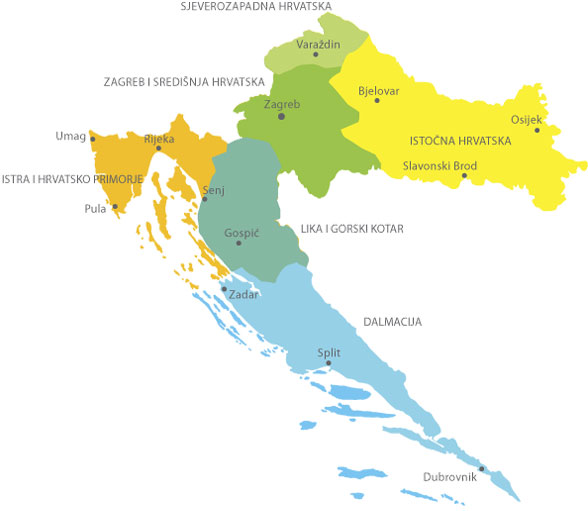
-

Central Croatia comprises Moslavina and Turopolje, Banovina and Kordun, Posavina, Podravina, as well as the capital, the city of Zagreb and its surroundings.
Geographically, the area is characterized by mild hills and river plains. Historically and economically, each region has developed its own specific features that are offered today as tourist attractions to visitors.
In addition to the traditional trades – agriculture and livestock farming – Moslavina is characterized by wine growing and exploitation of Moslavina oak timber. Discovery of oil and gas fields has stimulated the economic and social development of the region and has also reflected in the region’s tourism through development of thermae (spa) and institutions founded upon therapeutic properties of the mineral oil naftalan.
Turopolje is mostly agricultural territory, but there is also a significant area covered by the forests of hundred-year-old red oak inhabited by many species of birds. Subsequently, tourists have shown great interest in bird watching.
Banovina and Kordun are characterized by excursion areas along Mrežnica and Korana rivers, which are joined by Krka and Dobra Rivers as they flow through the city of Karlovac that dominates this area.
Posavina, the area along river Sava south of Zagreb, enriches the Croatian tourist map with another nature park – Lonjsko polje Nature Park – that in addition to its exceptional landscapes – meadows, pastures and floodplain forests – enchants with the specific architecture, folklore, crafts and popular cultural heritage.
Podravina is the borderline Croatian area along river Drava, towards Hungary, bound by the mountainsides of Macelj, Kalnik, Bilogora, Papuk and Krndija. Podravina is famous globally and within art circles as the birthplace of naïve painting represented by Ivan Generalić, Mirko Virius, Ivan Lacković Croata, Mijo Kovačić, Ivan Večenaj and Franjo Mraz.
-
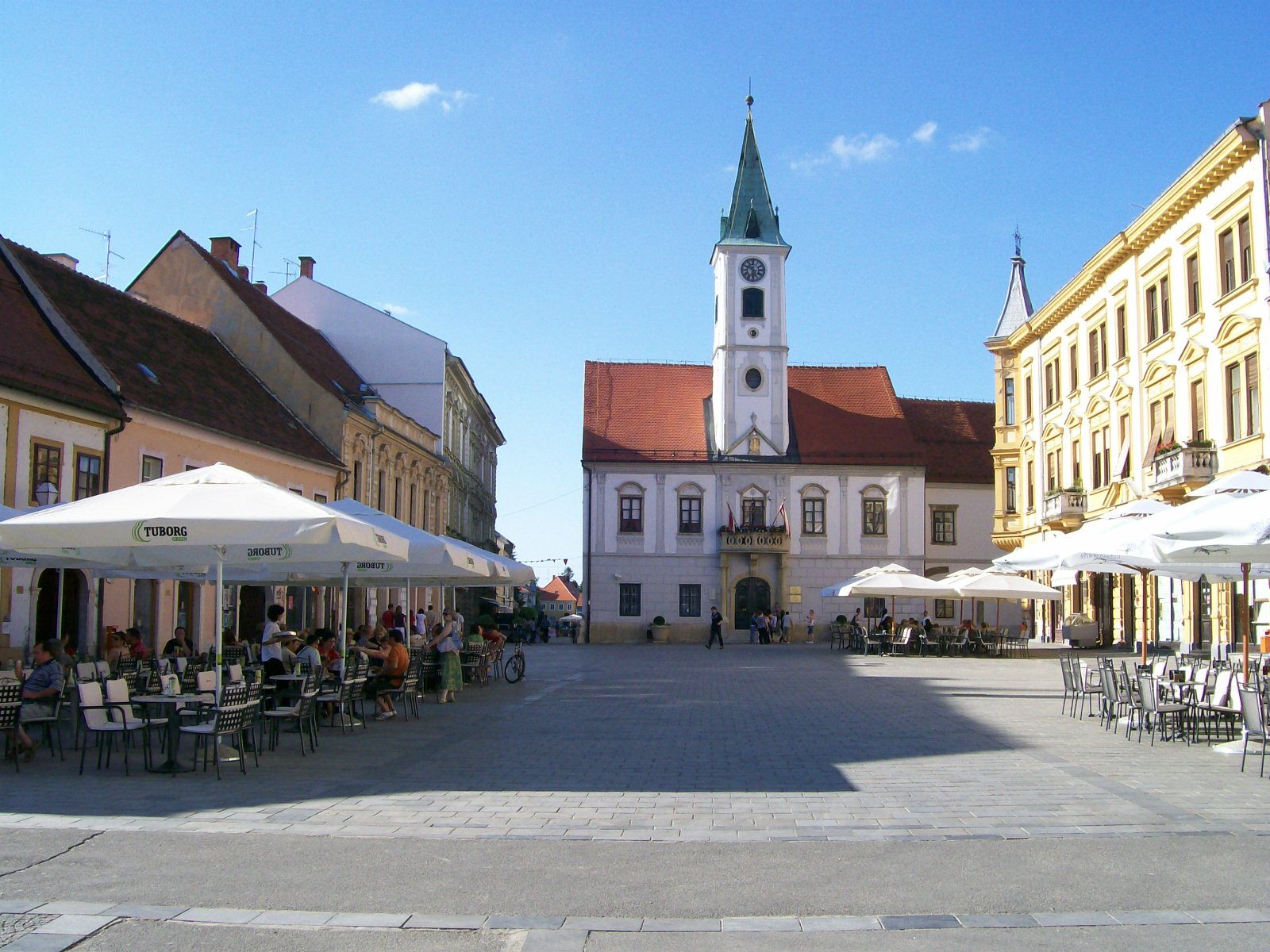
North-western Croatia comprises Hrvatsko zagorje and Međimurje, which are amongst the most developed regions of Croatia.
Picturesque hills of Hrvatsko zagorje attract many tourists who visit the numerous spas and medieval castles, the most famous of which are Trakošćan and Veliki Tabor. There are inhabitation traces in this area dating back to the stone age found near the city of Krapina (Krapina Early Man), and there are also significant archaeological finds of Roman thermae on the locality of present-time Varaždinske toplice. Hrvatsko zagorje is also where Croatia’s most famous pilgrimage site – Marija Bistrica – is located. The entire region gravitates towards Varaždin, as the largest city in the area, but also towards Zagreb in the hinterland of which it is located.
Međimurje is the northernmost area of Croatia, bound by the rivers Mura and Drava, and bordering Hungary and Slovenia. The area gravitates towards ÄŒakovec as the strongest urban centre. Regional development is based upon small entrepreneurship in textiles, footwear, agricultural production, as well as industry drawing upon traditional trades, such as basket weaving.
-

Eastern Croatia is mostly comprised of Slavonia, plus the easternmost territory of Hrvatska Baranja and Zapadni Srijem.
Slavonia is the Croatian granary, for the terrain is prevalently plain and the soil is the most fertile in the entire Croatia. It is a historic Croatian province where agriculture, livestock farming, food and timber industry was first developed. Besides boundless fields there are also numerous hunting grounds, vineyards of Kutjevo and Đakovo. Symbols of Slavonia are its forests of red oak and its gourmet sausage “kulen”.
The most important centres are Osijek, the largest Slavonian city, then Đakovo, Vukovar – the city globally known for the destruction it suffered during the war – and also Vinkovci, Virovitica, Slavonski Brod and Požega.
Slavonia offers the attractions of continental tourism: hunting tourism, spa, wine cellars, lavish and delicious continental cuisine, folklore heritage and natural attractions, the most prominent being Kopački rit – the wetlands area nature park and ornithological reserve alongside Dunav and Drava Rivers, as well as the mountain area of Papuk that has also been designated as a nature park.
Baranja stretches between Drava, Dunav and the Hungarian border. Its main centre is Beli Manastir, located 32 km from Osijek.
The easternmost part of Croatia is called Zapadni Srijem, and Ilok, its cultural, administrative and economic centre, is best known for its wine cellars.
-
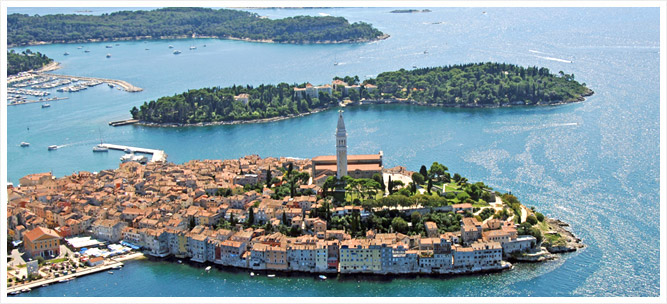
Istria is the largest Croatian peninsula and is also one of the Croatian regions and county administrative unit. Today's Istria is developing coastal and continental tourism, due to its Mediterranean climate, attractive throughout the year.
Due to the early civilization, this area is extremely rich in cultural and historical monuments, and the natural beauty of the Istrian coast and the interior make it an attractive tourist destination.
Istrian tourism is complemented with interesting programs: wine roads, bicycle routes, enogastronomic offer, hunting and fishing tourism, equestrian, ecological, agrotourism and overall exceptional accommodation capacities.
The administrative center of Istria is Pazin, and the economic Pula with some 58,500 inhabitants.
Istrian coastline is the lower Adriatic tourist gem: Umag, Novigrad, Poreč, Vrsar, Rovinj, Pula, Rabac ... But Istria is a mammal and an interior, medieval towns set on excursions, and in rural households tourists discover the charms of agrotourism.
In Istria is spent a wonderful holiday on the beaches, resting in nature in a quiet and quiet interior, revealing historical heritage, enjoying Istrian flavors and scents, indigenous wines, delighting with natural attractions, choosing among the numerous possibilities for active holidays, renewing life energy in wellness centers and chooses among the many cultural events.
The Croatian coast is part of the coastal part of Croatia from Rijeka to Karlobag, where the cities of Bakar, Kraljevica, Crikvenica, Bribir, Novi Vinodolski and Senj are located, which was the most important city of this area, leaving this role in the 19th century Rijeka. Mostly, the whole area today is mostly geared towards tourism.
-
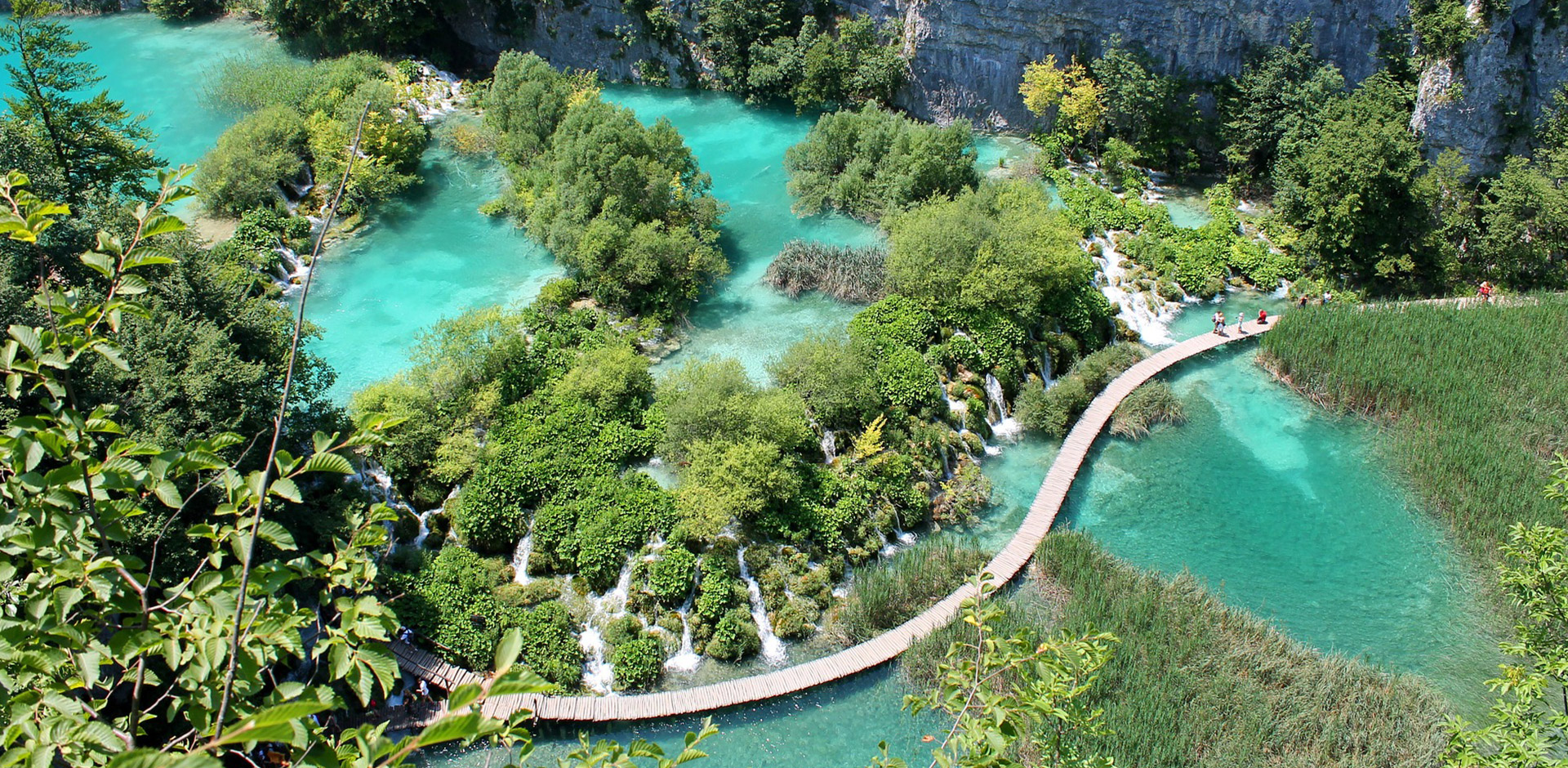
Lika and Gorski Kotar are the mountainous karstic Croatian regions that have their greatest contemporary potential in tourism.
Gorski kotar located between the Kvarner Bay and the valley of the Kupa River, which runs along the border with Slovenia, and among the mountains of the mountains lies fertile broad fields.
Rich forested potential, but also exceptionally alive and preserved wildlife, fresh mountain climate, are appealing to tourists at all times of the year, for winter tourism and winter sports, hiking and excursion tourism.The Croatian mountain regions are especially attractive because of the proximity of the Adriatic Sea and allow you to stay in fresh mountain retreats and hotels, and during the day you will quickly go to the nearby summer resorts.
The Plitvice Lakes National Park is located directly on the road linking Zagreb and Dalmatia, between the mountains of Mala Kapela and Lička Plješivica, in the eastern part of the Croatian region of Lika.
-
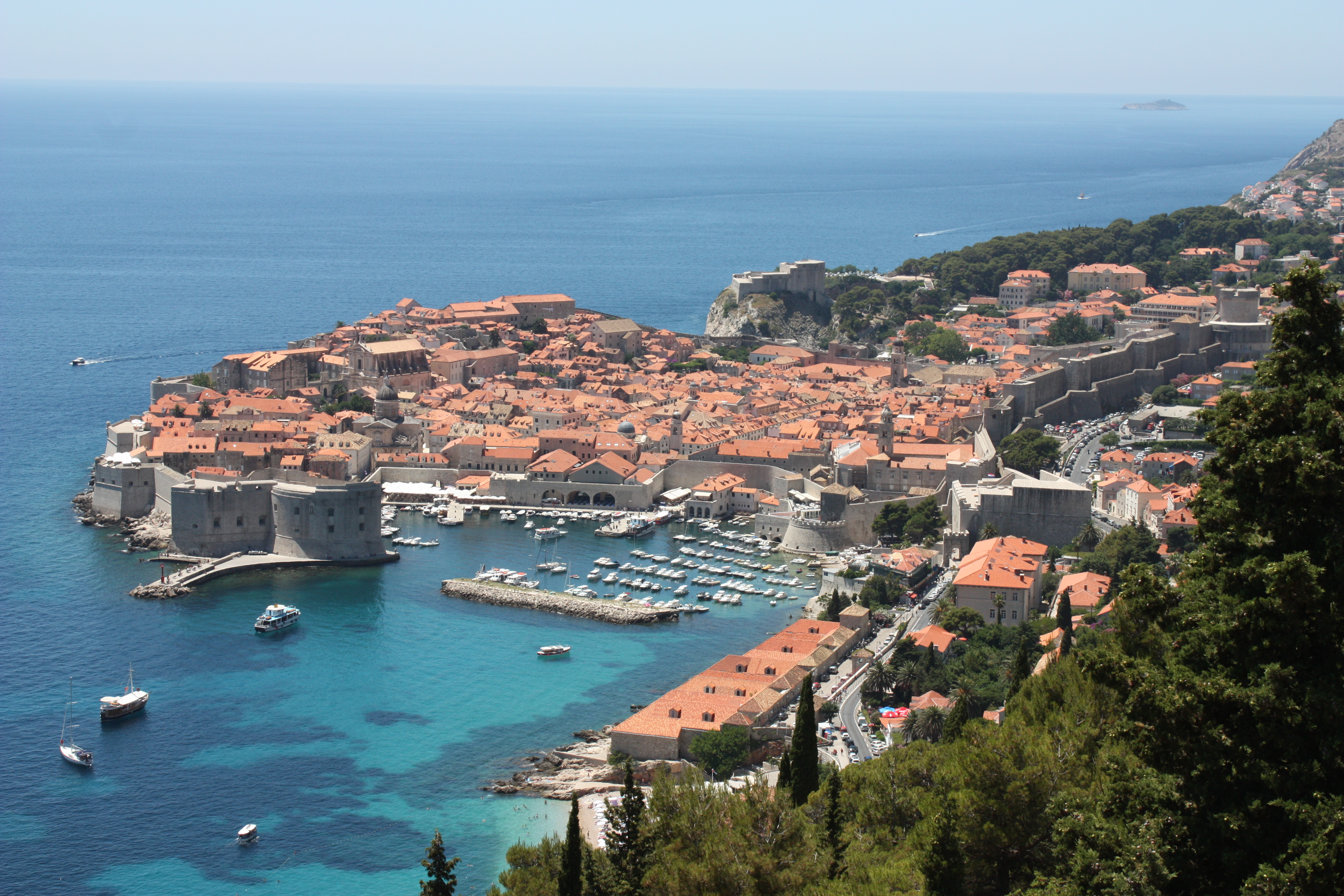
Dalmatia is the Croatian coastal region that stretches from Zadar and the island of Pag to the north to Kotor and the Garden to the south. Dalmatia is the most famous Croatian historical region. Taking the southern end of Croatia, it is a region of sun, warm sea, olive, wine, fish, songs and picturesque settlements with stone houses. Dalmatia is the Mediterranean and the largest tourist region of Croatia.
Dalmatia is marked by three large cities: three thousand years old Zadar, Split, the capital of the Roman emperor Diocletian and in the far south of Dubrovnik, listed on UNESCO's list of heritage. Along the whole coast there are tourist spots and riviera - Šibenik, Zadar and Makarska.
From the shore, countless countless islands are seen, as much as 1100, making the Croatian Adriatic coast one of the most indented on the Adriatic and therefore a favorite destination for sailors.
While a rich cultural and artistic program is taking place in the Dalmatian towns and offers a tour of a large number of cultural and historical monuments of various civilizations, smaller Dalmatian places offer a holiday in silence and an atmosphere filled with details of tradition.
Dalmatia is well-connected with the highway network, with direct access to the railway line and three airports: Zadar, Split and Dubrovnik. Numerous coastal and international ferry lines are also available in Dalmatian ports, which connect the mainland with the islands.
Private healthcare services in Croatia at the highest, European level.
From the Croatian Universities are coming highly educated doctors who later on through practice and additional education in the environment of high standards of Western medicine come to the top experts of their specialty. Clinics and equipment are also accompanied by high standards of Western Europe and the United States. We will select the institution that has the most experience in treating your illness and we will monitor you during and after treatment..
In view of your wishes and the need for consultation and / or examination with your doctor before your treatment reservation, we can arrange you a short visit to Croatia and the doctor which you are considering.






